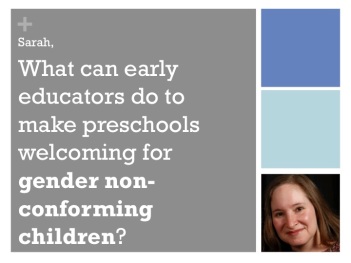Happy Real World Wednesday! This week we get to hear from Sarah Meytin!!!
Sarah is an ordained rabbi with an MSW. She has been in early childhood education since 2009, currently serving as assistant director of a Jewish preschool in Washington, DC. In 2013 she earned a National Director’s Credential from the McCormick Center for Early Childhood Leadership. She has also completed the Jewish Early Childhood Leadership Institute (JECELI) In 2010, Sarah founded Rockville Open House, a safe space for LGBTQ Jewish teens and their friends/allies, which meets monthly at the Jewish Community Center of Greater Washington.
We asked her: What can early educators to do make preschools welcoming for gender non-conforming children?
Here’s her insightful response:
A person’s gender or gender identity is their understanding that they are a boy, girl, man, woman, etc.. One’s gender identity is something known instinctively and may or may not “match” a person’s external genitalia, chromosomes, or what the doctor wrote down on their birth certificate. Children as young as 18months know their gender identity, and may understand their identity to be different from the gender they were assigned at birth. Gender expression is what we call the outward manifestation of gender, and is culturally determined. Gender expression includes the clothing, hair styles, personal preferences, and other “stereotypes” we associate with a particular gender identity.
The terms gender non-conformity or gender variance indicate that one’s gender expression does not match exactly, or at all, with the expected, or stereotypical, expression expected for one’s gender. In young children, this may include young girls who refuse to wear dresses or cut their hair very short, or boys who dislike sports and are more inclined to draw butterflies and rainbows than dinosaurs and trucks.
Creating Safe Spaces
To get you started creating safer and more welcoming early childhood programs for gender non-conforming young children, here are some tips:
- Educate yourself about gender identity, gender development, and sexuality.
- Allow each child to self-identify, including using their preferred pronouns, gender identification, and name preference
- Help parents to understand that most gender variant young children will outgrow this identity by the time they reach puberty, but some won’t.
- Expand assumptions of the gender-variant child and others: Remind them that they are “a different kind of boy (or girl)” and that there are “different ways to be a girl (or boy).” Be sure to educate other children, staff, and the parent community as well.
- Provide social support, including with other staff, parents, and other kids in the class
- Do this by emphasizing diversity and inclusiveness of all kinds, and with everyone in the community.
- Have gender neutral bathrooms/changing rooms.
- Avoid dividing children by gender – instead use birthday month, clothing color, letters of first/last name, etc.
- Provide resources, including books, that show diversity of families as well as gender expressions
To learn more, we recommending checking out the resources below and consider attending Sarah’s session, You Belong Here: Welcoming gender non-conforming children, at this year’s NAEYC Annual Conference.
Important Reads
- Recommended articles from Gan HaYeled Preschool’s gender variance workshop: ganhayeledpreschool.org/gender-variance-workshop-articles
- Transgender 101: A Simple Guide to a Complex Issue by Nicholas M. Teich
- The Gender Unicorn from Trans Student Educational Resources (TSER)
- 11 Myths, Misconceptions, and Lies About Gender Non-conforming Children by Brynn Tannehill
- Fact Sheet: Transgender & Gender Nonconforming Youth In School from the Sylvia Rivera Law Project
Resources for Classrooms
Same-sex parents
- King & King by Linda de Haan
- Two Dads: A book about adoption by Carolyn Robertson
- Daddy, Papa and Me by Lesléa Newman
- Mommy, Momma, and Me by Lesléa Newman
- And Tango Makes Three by Justin Richardson
- The Family Book by Todd Parr
Gender Variance
- My Princess Boy by Cheryl Kilodavis
- The Different Dragon by Jennifer Bryan
- Jacobs New Dress by Sarah Hoffman
- It’s OK to be Different by Todd Parr
- Red: A Crayon’s Story by Michael Hall
- Be Who You Are by Jennifer Carr (for elementary school children)
Wow! This is fantastic! Thank you Sarah!